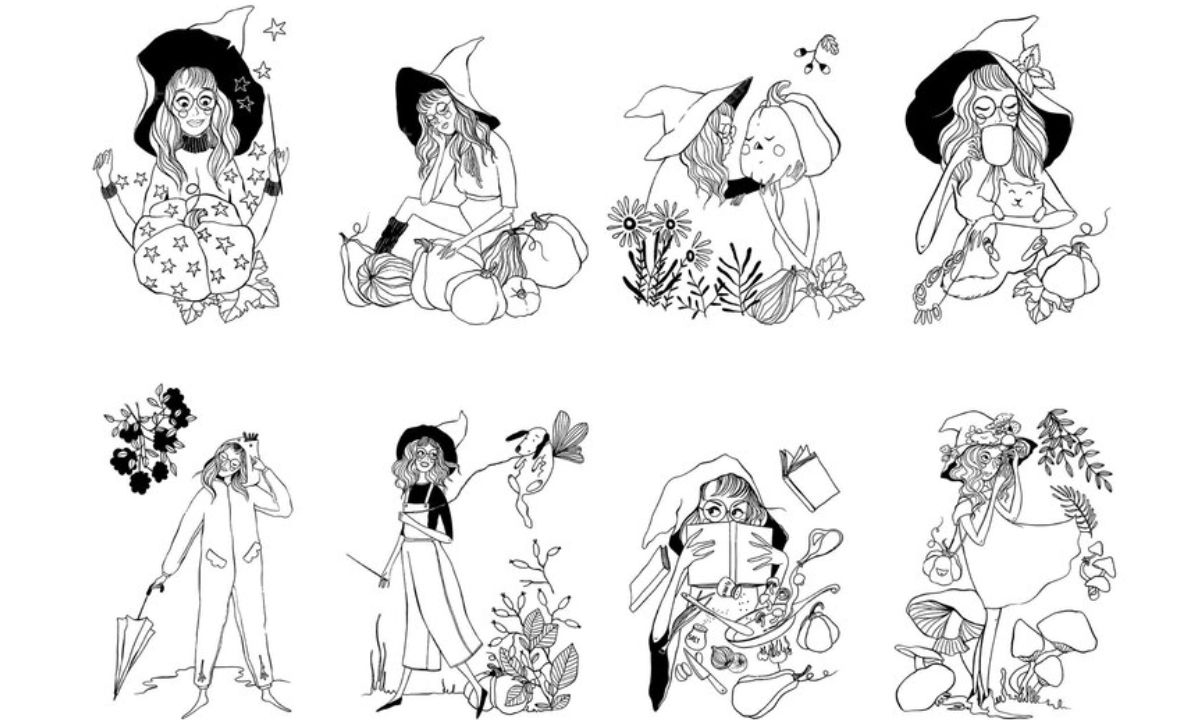Are you searching for fresh inspiration to breathe life into your sketchbook? Look no further! This comprehensive guide to aesthetic drawing ideas featuring cute girls will spark your creativity and help you develop your artistic skills.
Whether you’re a beginner looking for cute and easy drawing techniques or an experienced artist seeking new challenges, you’ll find something to love in these charming female drawings.
Aesthetic Drawing of a Cute Girl
The world of aesthetic drawing opens up endless possibilities for artistic expression. When we talk about creating adorable female sketches, we’re entering a realm where style, emotion, and technique blend to create visually appealing illustrations that capture the heart.
The aesthetic movement in art emphasizes beauty and emotional response over strict realism, making it perfect for creating cute aesthetic girls that convey feeling and personality.
What makes a drawing truly “aesthetic”? It’s a combination of harmonious elements: balanced composition, thoughtful color choices (or deliberate lack thereof), and an overall cohesive style that creates a specific mood or feeling.
When drawing cute girls in this style, artists often emphasize certain features—large expressive eyes, delicate facial structures, and stylized proportions—while maintaining an overall sense of charm and appeal.
Essential Elements for Aesthetic Cute Girl Drawings:
- Eyes – Often larger than realistic proportions, with careful attention to highlights and reflections
- Facial structure – Soft jawlines and delicate features create a sweet appearance
- Hair – Flowing, detailed hair adds movement and personality
- Expression – Subtle emotions that convey the character’s personality
- Stylistic consistency – Maintaining a recognizable style throughout your work
“The most beautiful thing about aesthetic art is that it doesn’t need to be perfect to be perfectly charming.” – Anonymous Artist
Trending in the US art scene are several distinctive aesthetic styles that have gained popularity through social media platforms like Instagram, TikTok, and Pinterest. These include the soft girl aesthetic (pastel colors, delicate features), the cottage core aesthetic (natural elements, vintage vibes), and the minimalist aesthetic (clean lines, limited palette).
Cute Black and White Girl
There’s something timelessly captivating about black and white drawing. This monochrome art style strips away the distraction of color, forcing both artist and viewer to focus on form, texture, and emotion. Creating a cute girl in B&W sketches allows you to explore the power of contrast and shading while maintaining an adorable, appealing character.
The advantage of working in black and white is that it challenges you to convey depth and dimension through value alone. This fundamental skill strengthens your overall artistic abilities, even when you return to color work.
Many professional artists regularly practice grayscale illustrations to sharpen their understanding of light and shadow.
Popular B&W Aesthetic Styles:
| Style | Characteristics | Best For |
| High Contrast | Bold blacks, clean whites, minimal gray | Dramatic, eye-catching illustrations |
| Soft Gradient | Smooth transitions between values | Dreamy, ethereal portraits |
| Hatching/Cross-hatching | Line-based shading technique | Textured, detailed drawings with vintage appeal |
| Pointillism | Dots create values and textures | Unique texture effects, patience required! |
| Ink Wash | Diluted black ink creates gray values | Painterly feel with ink medium |
How to Draw: Guide
Materials Needed:
- Smooth paper (Bristol board works well)
- Graphite pencils (HB, 2B, 4B, 6B)
- Blending stumps or tortillons
- Kneaded eraser
- Fine liner pen (optional)
Step 1: Basic Facial Proportions
Begin with a light sketch of basic proportions. For an aesthetic cute girl:
- Draw a circle for the head
- Add a small chin extending below the circle
- Divide the face vertically in half
- Place the eyes slightly below the halfway point
- Position the nose about halfway between eyes and chin
- Draw the mouth about one-third of the way between nose and chin
Step 2: Adding Defining Features
Now enhance your sketch with defining features:
- Draw large, expressive eyes with thick upper lashes
- Create a small, delicate nose (often just a simple curved line in aesthetic styles)
- Add a small mouth with a slight smile
- Sketch in eyebrows that follow the curve of the eyes
Step 3: Creating Contrast with Shading
This is where your B&W sketches come alive:
- Identify your light source direction
- Apply light shading (2B) to establish basic shadow areas
- Gradually build up darker values (4B, 6B) in the deepest shadow areas
- Leave highlights completely white
- Use blending stumps to smooth transitions between values
Step 4: Adding Final Details and Highlights
The finishing touches make all the difference:
- Add eye highlights (small white dots in the eyes)
- Refine hair details with varied line weights
- Enhance contrast in key areas
- Use your kneaded eraser to pull out subtle highlights
- Consider adding a fine liner for select outlines if desired
Common Mistakes to Avoid:
- Overblending, which can make your drawing look flat
- Creating symmetrical features (slight asymmetry looks more natural)
- Using the same line weight throughout
- Not allowing for enough contrast between light and dark areas
Cute Blue Girl
Blue has become increasingly popular in creative artwork, especially when creating cute aesthetic girls. This cool, calming color brings a distinct mood to your drawing of a cute girl and opens up fascinating artistic possibilities. From soft pastels to deep indigos, blue encompasses a wide spectrum that can convey everything from tranquility to melancholy.
Color psychology tells us that blue typically evokes feelings of peace, trust, and serenity. When applied to charming female drawings, these qualities can create characters that feel thoughtful, dreamy, or mysterious. The “blue aesthetic” has gained significant traction in contemporary art, partially due to its strong visual impact on social media platforms.
Different Blue Tones and Their Emotional Effects:
- Baby blue: Innocence, gentleness, childhood
- Teal: Creativity, uniqueness, sophistication
- Navy: Authority, trust, intelligence
- Periwinkle: Playfulness, curiosity, whimsy
- Turquoise: Clarity, freshness, youth
To create a truly captivating blue aesthetic drawing, consider complementary colors as accents. Orange-toned highlights can make your blue areas pop dramatically, while yellow accents bring warmth and energy to otherwise cool compositions.
How to Draw: Guide
Materials Needed:
- Drawing paper suitable for your medium
- Blue art materials (colored pencils, markers, watercolors, or digital software)
- White gel pen or white gouache (for highlights)
- Complementary colored accents (optional)
Step 1: Creating the Initial Sketch
- Begin with a light pencil outline of your cute girl
- Keep lines clean and minimal—this will be your guide
- Consider the overall composition and pose
- Plan where different shades of blue will be used
- Mark areas that will remain white or contain accent colors
Step 2: Layering Blue Tones
- Start with the lightest blue tones as a base layer
- Gradually build toward medium blues for general shading
- Apply darker blues sparingly for maximum depth
- Consider using analogous blues (blues that sit next to each other on the color wheel) for a harmonious effect
- Leave areas white where highlights will appear
Step 3: Adding Highlights and Shadows
This critical step brings dimension to your cute blue girl:
- Identify your light source and remain consistent
- Deepen shadows with your darkest blue or a complementary dark color
- Add white highlights to eyes, hair, and other reflective surfaces
- Create mid-tones by layering light blue over darker areas with gentle pressure
- Use blending techniques appropriate for your medium
Step 4: Finishing Touches to Enhance the Aesthetic
- Add fine details like individual hair strands or texture in clothing
- Consider adding subtle accent colors if desired
- Refine edges where needed
- Add final highlights with white gel pen or gouache
- Step back and check overall balance—make adjustments as needed
Case Study: The Blue Girl Project
Artist Marina Chen created a series of blue aesthetic girl illustrations that went viral on Instagram, gaining over 50,000 followers in three months. Her approach focused on creating characters with distinct personalities, all unified by a blue color scheme. She noted that the limited palette forced her to focus on expression and composition, ultimately strengthening her artistic skills.
Marina shared: “Working with blue taught me that limitations often lead to the most creative solutions. I learned to convey so much with just variations of a single color.”
Another Aesthetic B&W
Building on our exploration of monochrome art, let’s delve deeper into another approach to black and white drawing that creates uniquely striking aesthetic drawing results. This style plays with the dramatic potential of B&W sketches while maintaining the charm necessary for cute aesthetic girls.
The interplay between soft and sharp lines creates fascinating visual tension in monochromatic work. Sharp, precise lines can define key features or create focus areas, while soft, blended sections add depth and atmosphere. This contrast is particularly effective when drawing cute girls, as it allows you to create characters that feel both defined and dreamy simultaneously.
Texture plays a crucial role in successful grayscale illustrations. Without color to differentiate elements, texture becomes your primary tool for distinguishing between different surfaces—the smoothness of skin, the silkiness of hair, the weave of fabric. Developing a repertoire of texture techniques elevates your black and white drawing from basic to breathtaking.
Vintage vs. Modern B&W Aesthetics:
Vintage B&W aesthetics often feature:
- Cross-hatching and stippling techniques
- Film grain-like textures
- Dramatic lighting reminiscent of old photography
- Classic facial proportions
Modern B&W aesthetics typically include:
- Cleaner line work
- Strategic use of negative space
- Minimalist approaches to detail
- Contemporary fashion and styling elements
- Anime/manga influences
How to Draw: Guide
Materials Needed:
- Quality drawing paper
- Range of graphite pencils (HB through 8B)
- Charcoal pencil (optional for deeper blacks)
- White gel pen or white charcoal pencil
- Blending tools
- Fixative spray
Step 1: Planning Your Composition
- Begin with thumbnail sketches to determine your overall composition
- Decide on lighting direction and intensity
- Identify your focal point (usually the face in cute girl drawings)
- Plan your value structure (where the darkest darks and lightest lights will be)
- Consider negative space as an active element in your design
Step 2: Creating Dramatic Contrasts
The key to compelling B&W work is thoughtful contrast:
- Establish your darkest darks and lightest lights first
- Create a value scale from 1 (white) to 10 (black) and identify where each major element falls
- Group similar values to create cohesive areas that guide the viewer’s eye
- Use contrast strategically—highest contrast at your focal point
- Remember that too much contrast everywhere creates visual chaos
Step 3: Detailed Shading Techniques
Now employ various shading techniques for visual interest:
- Hatching: Parallel lines for uniform areas
- Cross-hatching: Overlapping lines in different directions for darker values
- Stippling: Dots of varying density for texture
- Blending: Smooth transitions with tortillons or blending stumps
- Scumbling: Circular marks for organic textures
Step 4: Adding Texture and Pattern Elements
- Identify different textures needed (hair, skin, clothing, etc.)
- Use appropriate techniques for each texture
- Add patterns where they enhance the aesthetic (decorative elements on clothing, background textures)
- Maintain consistency in your approach to similar textures
- Remember that even small texture details contribute to the overall mood
Tips for Creating Depth in B&W Drawings:
- Atmospheric perspective: Lighter pressure and less contrast for distant elements
- Overlapping: Clear foreground/background relationships
- Size variation: Larger elements feel closer
- Detail density: More details in foreground, fewer in background
- Value control: Strategic use of your full value range
Cute Girl with Jean Jacket
Fashion elements add personality and contemporary relevance to your aesthetic drawing ideas. A cute girl with jean jacket combines timeless style with artistic appeal, creating illustrations that feel both trendy and accessible. This concept offers rich opportunities to explore texture, proportion, and character development in your artistic sketching.
Denim presents a fascinating texture challenge for artists. The characteristic weave, folds, and wear patterns of denim create visual interest that can elevate your drawing of a cute girl from basic to compelling. Learning to render denim effectively is a valuable skill that transfers to many other fabric textures in your artistic journey.
When incorporating fashion elements like a jean jacket, consider how the clothing reflects your character’s personality. Is the jacket oversized and comfortable? Fitted and stylish? Distressed and casual? These choices contribute to the storytelling aspect of your artistic drawing and help viewers connect with your creation.
Tips for Drawing Realistic Jean Jacket Textures:
- Study reference images – Notice how denim catches light, creates shadows, and forms characteristic folds
- Establish the weave pattern – Subtle diagonal lines suggest the fabric’s structure
- Add strategic wrinkles – Concentrate folds where the fabric bends (elbows, shoulders, cuffs)
- Create depth with shading – Use varied pressure to show how light interacts with the material
- Include details like seams, buttons, and pockets – These elements make the jacket recognizable
- Consider worn areas – Lighter areas at stress points add authenticity
- Balance detail with overall aesthetic – Too much texture can overwhelm your cute girl drawing
“Fashion in art isn’t just about drawing clothes—it’s about expressing character, time period, and mood through what someone wears.” – Fashion Illustrator Blair Breitenstein
Current fashion trends worth incorporating into your cute girl with jean jacket drawings include oversized silhouettes, crop cuts, embroidered details, and vintage-inspired elements. These trends resonate particularly well with the US audience and can make your illustrations feel current and relatable.
Very Simple Cute Girl
There’s profound beauty in simplicity. Creating a very simple cute girl drawing challenges you to identify the essential elements that communicate character and charm with minimal marks on the page. This approach to aesthetic drawing embodies the “less is more” philosophy while still creating engaging, appealing art.
The minimalist aesthetic has gained significant traction in contemporary art circles, partly as a response to our visually overwhelming digital environment. A simple sketches approach offers viewers visual breathing room while demonstrating artistic confidence and control. These beginner-friendly art techniques are accessible to artists of all skill levels while offering plenty of room for personal expression.
The Key Principles of Minimalist Cute Girl Drawings:
- Identify essential features – What’s the minimum needed to recognize a face?
- Use confident, deliberate lines – Each mark should have purpose
- Embrace negative space – The untouched areas are as important as the drawn elements
- Focus on proportion relationships – Simple doesn’t mean careless
- Create visual interest through selective detail – Choose where to add complexity
The Impact of Simplicity: Minimalist art creates immediate visual impact through restraint. By eliminating unnecessary details, you direct the viewer’s attention exactly where you want it. This approach can create surprisingly powerful emotional connections despite (or perhaps because of) its simplicity.
How to Draw: Guide
Materials Needed:
- Smooth paper
- Fine-tipped pen (0.3-0.5mm works well)
- Light pencil for planning (optional)
Step 1: Simplifying Facial Features
- Start with the absolute basics—a simple outline for the head shape
- Decide which features are essential (typically eyes and mouth at minimum)
- Reduce eyes to their most basic recognizable form
- Consider using just a simple curve for the mouth
- Decide if a nose is necessary—often a single dot or small line suffices
Step 2: Creating Recognizable Silhouettes
Silhouettes are crucial in minimalist art:
- Keep the overall head shape simple but distinctive
- Consider hair as a major defining element of your character
- Use basic geometric shapes as building blocks
- Ensure the silhouette reads clearly even at a small size
- Test your silhouette by filling it in solid black—is it still recognizable?
Step 3: Adding Minimal Details That Count
This is where your cute drawing idea comes to life:
- Add 1-3 distinctive details that give personality (hair accessory, glasses, expression)
- Keep details consistent with your minimal approach
- Place details strategically to create visual balance
- Remember that even small additions draw significant attention in minimal art
- When in doubt, leave it out—you can always add more later
Step 4: Finalizing Your Simple Aesthetic Drawing
- Review your drawing for unnecessary elements
- Check that your minimal lines communicate effectively
- Ensure your character still feels cute and appealing
- Consider if your drawing needs one final distinctive detail
- Embrace the beauty of simplicity in your finished piece
Finding Balance Between Simplicity and Expression:
The challenge with minimalist cute aesthetic girls is maintaining expressiveness with limited elements. Experiment with:
- Various eye shapes to convey different emotions
- Slight changes to mouth curves for different expressions
- Head tilts to suggest attitude or emotion
- Simple line variations to imply movement
- Minimal color accents (if desired)
Cute Sulky Girl
Capturing emotion adds depth and relatability to your aesthetic drawing. A cute sulky girl presents a fascinating artistic challenge: balancing the appealing qualities of cute drawing ideas with more complex emotional expressions. This contrast creates characters that feel more authentic and engaging than perpetually happy figures.
The appeal of the sulky, pouty, or slightly moody aesthetic has grown significantly in recent years, particularly in artistic sketching influenced by anime, K-pop, and alternative fashion styles. These emotive girl sketch concepts allow for storytelling and character development within a single illustration.
Facial expressions are your primary tool for conveying emotion. For a cute sulky girl, focus on these elements:
- Eyebrows – Slightly furrowed or one raised higher than the other
- Eyes – Looking sideways or slightly downward, perhaps with a small tear
- Mouth – A subtle pout or small frown, sometimes with one corner slightly raised
- Cheeks – Possibly slightly puffed or with a light blush
- Overall head position – Often tilted slightly down or to one side
Body language significantly enhances emotional expression. Consider these postures for your cute sulky girl:
- Arms crossed defensively
- Shoulders slightly hunched
- Head turned slightly away
- Feet pointed inward
- One hip cocked to the side
The Psychology Behind “Sulky Cute”:
The “sulky cute” aesthetic works because it combines vulnerability with defiance—a complex emotional state that feels authentic and relatable. Psychologically, viewers often find slightly negative emotions more interesting and nuanced than simple happiness. This complexity creates characters that invite viewers to imagine a backstory and connect more deeply with the illustration.
Simple Lines
The art of simple lines forms the foundation of compelling aesthetic drawing. This approach focuses on the expressive quality of line work itself, using variations in pressure, direction, and continuity to create charming female drawings with minimal additional elements. Mastering line work is fundamental to developing your own recognizable artistic sketching style.
Line weight—the thickness and darkness of your lines—communicates crucial information to viewers. Thicker lines typically bring elements forward and create emphasis, while thinner lines recede and suggest delicacy. Varying line weight thoughtfully throughout your drawing of a cute girl creates visual hierarchy and guides the viewer’s eye.
The direction of your lines creates movement and energy in your illustrations. Lines can be:
- Horizontal: Suggesting calm, stability, restfulness
- Vertical: Implying strength, dignity, growth
- Diagonal: Creating dynamic energy, movement, tension
- Curved: Conveying grace, beauty, flexibility
Achieving Line Variety in Your Aesthetic Drawings:
| Line Quality | Artistic Effect | Best Used For |
| Thin, light | Delicacy, distance | Background elements, subtle details |
| Thick, dark | Emphasis, proximity | Outlines, focal points |
| Continuous | Confidence, flow | Hair, clothing drape |
| Broken/dotted | Texture, uncertainty | Shading, implied edges |
| Angular | Energy, sharpness | Dynamic poses, dramatic elements |
| Curved | Grace, softness | Facial features, organic forms |
How to Draw: Guide
Materials Needed:
- Smooth paper that complements your chosen medium
- Various pens/pencils in different thicknesses
- Steady hand and comfortable drawing position
Step 1: Practicing Different Line Techniques
Before starting your final drawing, practice these essential line techniques:
- Pressure variation: Create lines that transition from thin to thick by changing pressure
- Speed variation: Notice how line quality changes when drawing quickly versus slowly
- Directional lines: Practice lines that follow the form they’re describing
- Tapering: Create lines that gracefully taper at their ends
- Connecting lines: Practice smooth transitions where lines meet
Step 2: Creating Expressive Outlines
- Begin with light, exploratory lines to establish basic proportions
- Decide which lines will be emphasized in your final drawing
- Apply appropriate pressure to create varied line weights
- Pay special attention to outline continuity around key features
- Consider where lines might break or fade for artistic effect
Step 3: Adding Minimal Interior Lines
Interior lines add definition and form:
- Use lighter, thinner lines for interior details
- Add only essential interior lines that define structure
- Consider the direction of these lines—they should follow the form
- Use interior lines to suggest volume and dimension
- Resist the urge to add too many—remember, simplicity is key
Step 4: Perfecting Your Line Art
- Check for consistency in your approach
- Ensure line weight variations serve a purpose
- Look for awkward transitions or connections
- Clean up any stray or unnecessary marks
- Consider selective areas where lines might be omitted entirely
Tools for Creating Clean, Aesthetic Lines:
- Fineliner pens (0.05 to 1.0mm): For precise, consistent lines
- Brush pens: For dramatic line weight variations
- Technical pencils: For preliminary sketching
- Tablets with pressure sensitivity: For digital line work
- Rulers/French curves: For precise geometric elements (use sparingly)
Developing your own distinctive line style takes practice, but it’s one of the most rewarding aspects of creating aesthetic drawing ideas. Your unique line quality becomes a signature element that makes your cute drawing idea instantly recognizable as your own work.
Cute Girl Holding Flowers
Incorporating natural elements like flowers creates visually rich aesthetic drawing ideas. A cute girl holding flowers combines the appeal of charming female drawings with the symbolic and visual beauty of botanical elements. This combination opens up exciting possibilities for color, composition, and storytelling in your artwork.
Flowers carry rich symbolic meanings across cultures, adding depth to your artistic sketching. Some common flower meanings include:
- Roses: Love, passion, beauty
- Daisies: Innocence, purity, new beginnings
- Sunflowers: Adoration, loyalty, longevity
- Lilies: Majesty, transition, fertility
- Cherry blossoms: Fragility of life, beauty, renewal
When creating a blossoming girl illustration, consider the relationship between the character and the flowers. Are they an extension of her personality? A gift she’s receiving? Something she’s gathered herself? This relationship influences pose, expression, and the overall mood of your drawing.
Compositionally, balancing the girl and flowers requires thoughtful planning. Consider these approaches:
- Framing: Using flowers to frame the girl’s face or figure
- Integration: Weaving flowers into her hair or clothing
- Contrast: Setting delicate flowers against more solid figure elements
- Foreground/background: Playing with depth by placing flowers in different planes
- Scale relationships: Varying flower sizes for visual interest
How to Draw: Guide
Materials Needed:
- Reference images of flowers
- Your preferred drawing media
- Understanding of basic flower structures
Step 1: Sketching the Pose and Flower Placement
- Begin with a simple pose that naturally incorporates the flowers
- Consider how the hands will hold or interact with the flowers
- Decide on flower types and rough placement
- Establish the basic proportions of both girl and flowers
- Create a balanced composition that honors both elements
Step 2: Detailing the Flowers
Flowers have specific structures worth understanding:
- Start with basic geometric shapes that underlie each flower type
- Add petals, working from the center outward
- Consider the viewing angle—flowers look dramatically different from different perspectives
- Add stems, leaves, and any additional botanical elements
- Pay attention to natural growth patterns and petal arrangements
Step 3: Adding Texture and Depth to Petals
- Observe how light interacts with flower petals—they often have translucent qualities
- Add appropriate shading to create form and dimension
- Consider the texture of different petals (velvety, smooth, ruffled)
- Add subtle details like veins in leaves or texture on stems
- Use highlights strategically to suggest the delicate nature of petals
Step 4: Creating Harmony Between the Girl and Flowers
This critical step unifies your girl-focused artistry:
- Ensure consistent lighting across both the girl and flowers
- Create color harmony (if using color) that complements both elements
- Balance detail levels—neither element should overwhelm the other
- Use overlapping to establish clear spatial relationships
- Refine edges where girl and flowers interact
Tips for Drawing Different Types of Flowers:
- Roses: Start with a spiral center and add increasingly larger petals outward
- Daisies: Create a circle center with evenly spaced, elongated petals
- Tulips: Use a modified U-shape with slightly pointed petal tips
- Sunflowers: Draw a large center circle with two layers of pointed petals
- Cherry blossoms: Five rounded petals with a small center
Case Study: Floral Aesthetic Engagement
Illustrator Emma Chen’s series of girls with seasonal flowers garnered impressive engagement on social media, with her spring collection receiving 300% more interaction than her standard portraits. In a creator interview, she noted: “Flowers add an emotional dimension to character illustrations. They’re familiar yet magical elements that viewers immediately connect with on both aesthetic and emotional levels.”
Wrap up
We’ve explored a diverse range of aesthetic drawing ideas for creating cute aesthetic girls in various styles and techniques. From the dramatic impact of black and white drawing to the expressive potential of simple lines, these approaches offer something for artists at every skill level. The beauty of these charming female drawings lies in their versatility—you can adapt them to your personal style while maintaining their essential appeal.
As you develop your own cute drawing idea collection, remember that practice is essential. Set aside regular time to experiment with these techniques, combining elements that resonate with your artistic vision. The most compelling artistic sketching comes from authentic exploration and personal connection to your subject matter.
Key Takeaways:
- Aesthetic appeal comes from thoughtful composition, stylistic consistency, and emotional resonance
- Limiting your palette (as in B&W or blue drawings) often strengthens your fundamental artistic skills
- Simplicity can be just as impactful as complexity when executed with intention
- Emotional expression adds depth and relatability to cute character drawings
- Line quality forms the foundation of distinctive artistic style
- Combining characters with symbolic elements like flowers creates rich visual storytelling
“The most beautiful aesthetic combines simplicity with meaning. When you find that balance in your art, you’ve discovered something truly special.” – Contemporary Artist Minh Nguyen
I encourage you to take these aesthetic drawing ideas and make them your own. Develop your unique approach to creating cute aesthetic girls by experimenting with different techniques, combining styles, and following your artistic intuition. Share your creations with supportive communities to receive feedback and inspiration from fellow artists.
Remember that artistic growth comes from consistent practice and thoughtful experimentation. Each drawing brings you closer to developing your signature style and expanding your creative capabilities. The journey of artistic discovery is as rewarding as the finished illustrations themselves.
What aesthetic drawing ideas will you try first? The possibilities are endless—pick up your drawing tools and let your creativity flow!










